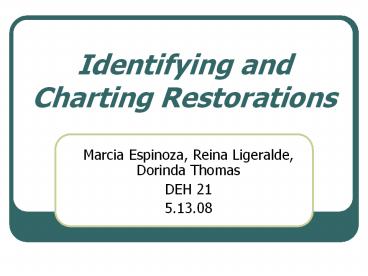Identifying and Charting Restorations PowerPoint PPT Presentation
Title: Identifying and Charting Restorations
1
Identifying and Charting Restorations
- Marcia Espinoza, Reina Ligeralde, Dorinda Thomas
- DEH 21
- 5.13.08
2
Common Dental Materials
- Amalgam
- Composite
- Porcelain
- Sealant
- Veneer
- Post
- Fixed Partial Denture
- Inlay
- Onlay
3
Amalgam
- An alloy that consists chiefly of silver mixed
with mercury and variable amounts of other metals - Appears radiopaque radiographically
4
Amalgam Appearances
- Clinical
Radiographic
5
Composite
- Also called a white filling
- Typically consists of a resin-based matrix and an
inorganic filler (which gives the composite
wear-resistance and translucency) - May appear radiopaque radiographically (older
ones may appear radiolucent)
6
Composite Appearance
Clinical
Radiographic
7
Porcelain
- Produced by mixing ceramic powder with distilled
water - Appears radiopaque radiographically
8
Porcelain Appearances
- Clinical
Radiographic
9
Sealant
- A tough, plastic material designed to bond to the
tooth enamel - Clear or tooth-colored material that seals the
pits and grooves - Not seen radiographically
10
Sealant Appearances
- Clinical
Radiographic
- Not seen but possibly a faint radiopacity on
occlusal surface
11
Veneer
- A thin layer of restorative material placed over
a tooth surface, either to improve the aesthetics
of a tooth, or to protect a damaged tooth surface - Two types of materials can be used in a veneer
composite and porcelain - Appears radiopaque radiographically
12
Veneer Appearances
Clinical
13
Post and Crown
- Often, only the root portion is left to retain
the crown. - A gold casting called a post and core
- Common practice to cement a post about two-thirds
of the way into a root canal - Core the part of the post that protrudes from
the root canal
14
Post and Crown Radiograph
15
Fixed Partial Denture (FPD)
- Designed to replace more than one missing natural
tooth - Dentist attaches an FPD to natural teeth
(abutments) or roots by cementation - Pontic artificial tooth suspended from the
retainer casting, occupies the space formerly
filled by the crown of a natural tooth - Unit castings are joined together by connectors.
- The units may be made entirely from metal,
combination of metal or resin, or from a
combination of metal and porcelain.
16
FPD aka Bridge Appearance
17
Inlay vs. Onlay
18
Inlay vs. Onlay Clinical Appearances
Inlay
Onlay
19
Surface Restorations
- Examples O, B, L, DO, MO, MOD, MOB, OL, OB, MF,
ML, DF, or DL - A dental restorative material used to
artificially restore the function, integrity, and
morphology of missing tooth structure - Appears radiopaque radiographically
20
Surface Restoration Appearances
- Clinical
Radiographic
21
How to Identify Dental Materials Clinically
- Tactile detection
- Composite restorations have a distinct tactile
feel with the explorer that contrasts with a
natural tooth or a ceramic or porcelain
restoration. - A black line of metal may be apparent when an
explorer is used on the material. - Air
- Aesthetic restorations may reveal a dry, chalky
appearance when air is applied.
22
Charting Restorations
- Use blue ink and draw symbol for existing
restoration. - Place appropriate letter for restoration material
(e.g. A, C, P, V) on facial or buccal aspect of
chart, above/below root apices. - Place an S on the occlusal surface of the tooth
that has a sealant.
23
More on Charting Restorations
- For a bridge, mark missing tooth/teeth with
straight line, outline the crowns of teeth, and
fill in with diagonal lines. Draw 2 sets of
parallel lines between crowns of teeth. Place
appropriate letter representing type of material
on facial or buccal. - Mark a straight line inside root areas(s) of
affected tooth for a root canal therapy.
24
Test YOUR Knowledge!
- Identify 3 incorrect charted restorations.
25
(No Transcript)
26
Amalgam or Stain?
- Name two ways you can tell if your patient has an
amalgam or a stain.
27
Composite or Sealant?
- What is the difference between the two?
28
Answers
- 4 - P should be on the buccal, not the lingual,
aspect of the chart, above the apices. - 14 S should be on the occlusal surface rather
than on the buccal aspect of the chart, above the
apices. - 31 Blue, rather than black, ink should have
been used.
29
More Answers
- You can use tactile detection and air. With
tactile detection, there will be a distinct
difference in sound. There is more of a solid
ringing noise when an explorer goes across a
restoration and more of a jagged, scratching
noise when an explorer runs along a tooth surface
that has a stain, especially if the tooth surface
has pits. - A composite will cover a surface whereas a
sealant will cover a pit or groove.
30
Questions?

